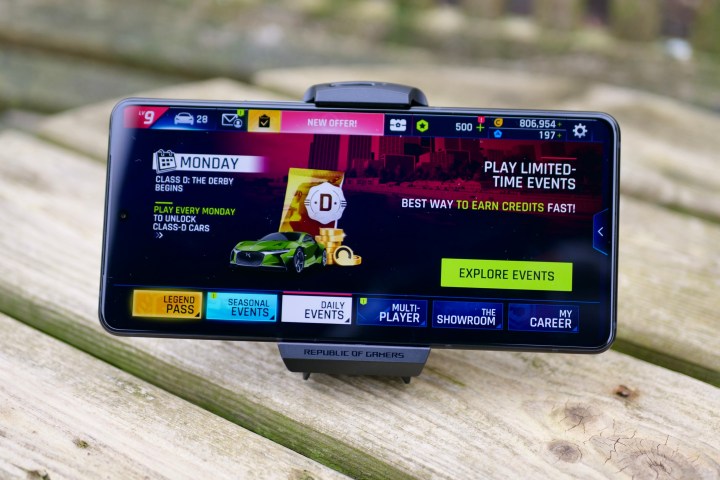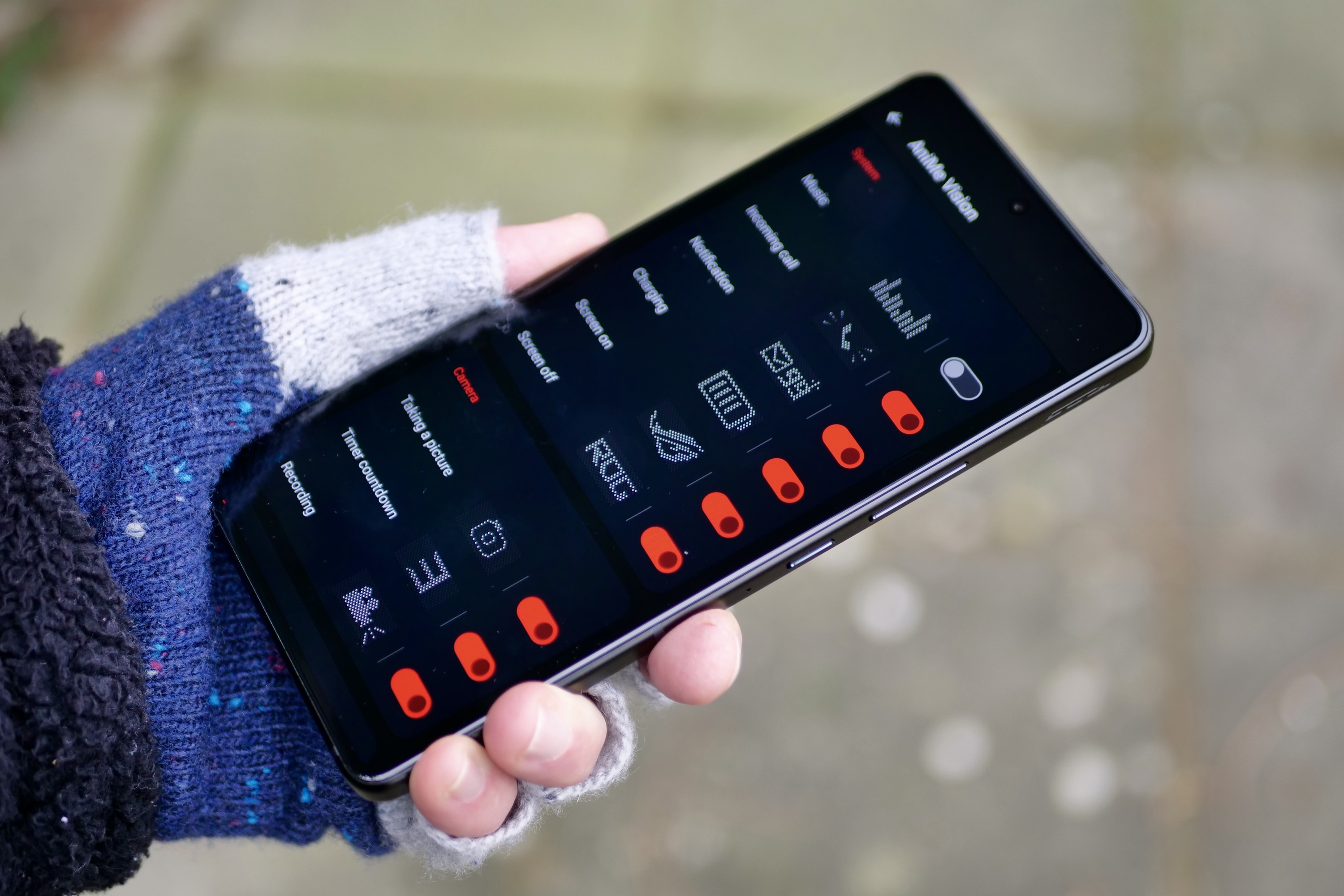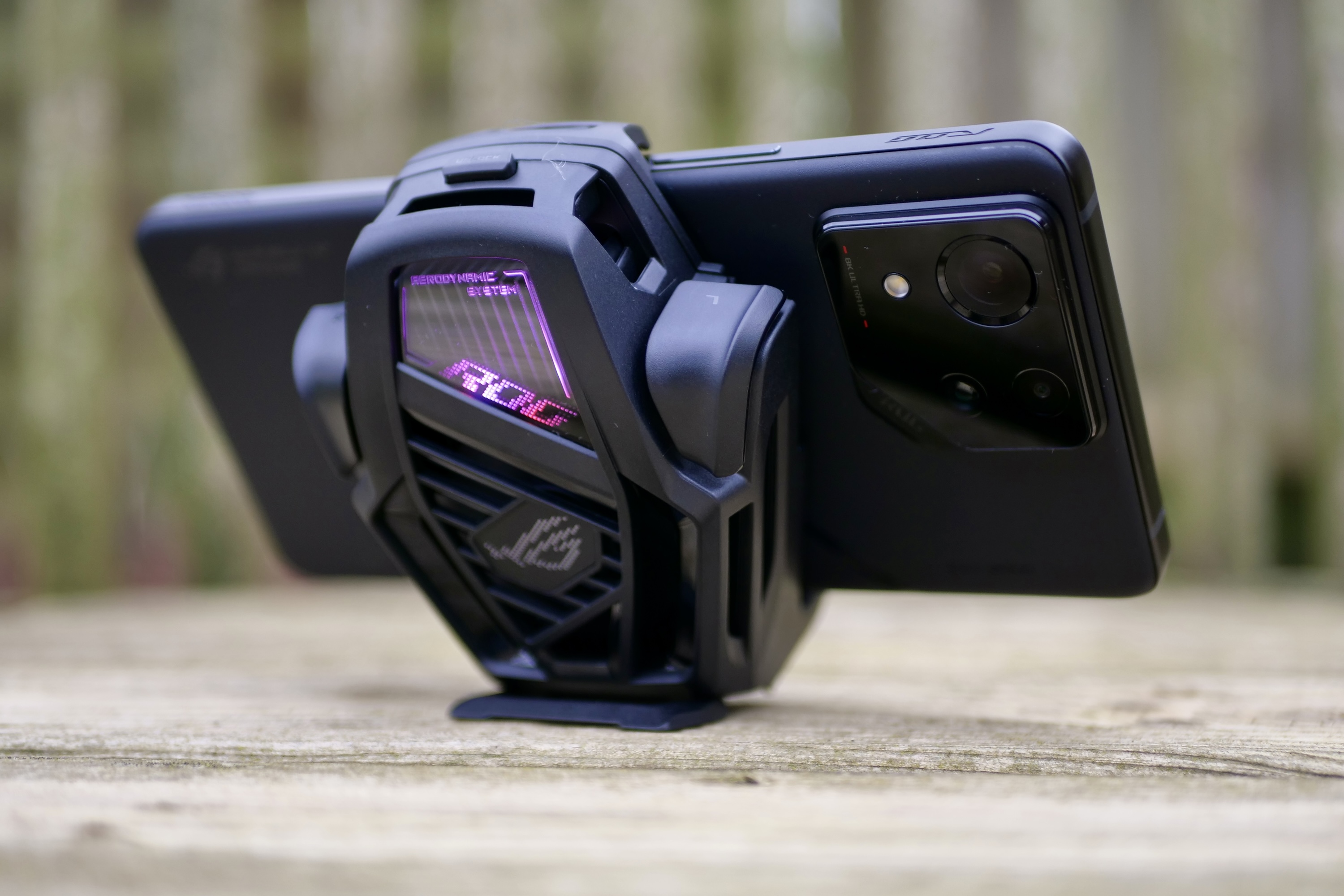
“The Asus ROG Phone 8 Pro is the best phone you can buy if you want to play games, but it turns out it’s also a great everyday phone.”
- Great gaming software features
- AirTriggers work really well
- Hugely powerful
- IP68 rating
- Fast wired charging
- Fewer hardcore gaming features
- Gets hot when pushed to its limit
Is the Asus ROG Phone 8 Pro still a gaming phone? After all, it’s a very different beast visually from the models we’ve seen before. Don’t worry — the ROG Phone 8 Pro is still all about games, but while the previous models were the phone equivalents of a gaming PC, the ROG Phone 8 Pro is more like a PlayStation.
It still has all the right gaming credentials, but without all the hassle. Has this switch destroyed everything that made the ROG Phone series so unique? I’ve been finding out.
Asus ROG Phone 8 Pro: design

Asus has taken the ROG Phone series mainstream, or as mainstream as it’s ever likely to get. It claims the phone is “not just a gaming phone, but also an all-round premium phone for everyday use,” making it quite different from the ROG Phones that have gone before it. Over the past few weeks, I’ve been able to test if it really is a more capable everyday device, as it has been my companion through an exceptionally busy period when playing games simply wasn’t going to happen, and calls, messages, and emails were the priority.
I’d come to the phone from using the Nothing Phone 2, the Samsung Galaxy S23 Ultra, and the OnePlus 11 in quick succession, so it had a lot to live up to. The good news is it has been as capable, convenient, and reliable as any of them when used as a normal smartphone. If I had been using the ROG Phone 7 Ultimate during this time, I’m pretty sure I wouldn’t have felt the same way. The reason for this is Asus’s decision to change the overall design of the ROG Phone.

It has smaller bezels around the screen, a more conventional shape, a thinner 8.9mm profile, and a lighter 225-gram weight. The AirTriggers are still on each shoulder, but there are no more motorized vents, so it has gained an IP68 water and dust resistance rating. The 3.5mm headphone jack remains, as does a side-mounted USB-C charging port. It’s certainly still more suited to gaming than most flagship smartphones, but it’s far less compromised. It represents a massive change for the ROG Phone series, and a mostly positive one, too.
Only mostly? The problem is that the ROG Phone 8 Pro isn’t as mad, or as fully gaming-centric, as previous models. Nor is it as eye-catching. The rear panel on the Pro is all black, and the crisp and clear LED array that brightly shows different animations is entirely hidden when it’s turned off. When it is, the back of the ROG Phone 8 Pro is shockingly ordinary, although the subtle sparkle and matte flashes do give it a visual boost. Even the camera module is a simple, square black section in the top corner that’s slightly raised.
The ROG Phone 8 Pro is a comfortable and convenient everyday partner.
It’s clearly designed to give the phone more mass appeal, in addition to making it more usable, but there is a risk of turning the hardcore repeat ROG Phone buyers off as it’s missing much of what made the older models so different. The ROG Phone 8 Pro is a comfortable and convenient everyday partner when I’m not playing games, which can’t be said about any other ROG Phones, but there will inevitably be some who are entirely turned off by that statement.
Asus ROG Phone 8 Pro: gaming

Asus still insists the ROG Phone 8 Pro is a gaming smartphone, despite it edging closer to the mainstream than before, so what’s it like when you do play games? As mentioned, the AirTriggers are still present on each shoulder and can be programmed to operate in any mobile game. Also, Asus’ X Mode is available to supercharge performance whenever you want while keeping it manageable to extend battery life when you don’t. I like that each of these features is easily accessible by long-pressing the Quick Settings button, and they are entirely customizable too.
Running the 3DMark benchmarking app’s Wild Life Extreme Stress Test revealed the phone gets very hot with such treatment, particularly on the sides of the chassis. It’s in these arduous situations where you will want to use the AeroCooler X fan accessory that clips on the back to aid cooling with its physical fan. It adds a pair of customizable buttons as well. It also activates X Mode Plus on the phone to squeeze even more performance out of the device. Under normal circumstances, comprehensive cooling methods, ranging from copper and graphite sheets to boron nitrate injected into cavities, keep it running at a sensible temperature.

You look at a 6.78-inch flexible AMOLED screen with a 1-120Hz refresh rate, which automatically boosts to 165Hz when playing compatible games. Disappointingly, the resolution is 2400 x 1080 pixels, meaning it’s not quite as high as some gamers may want, but it matches previous versions of the phone. It has a peak brightness of 2,500 nits, and although it hasn’t been sunny or bright while I’ve been testing the phone, it has never been a problem to see the screen outside. I’ve also found the automatic brightness adjustment to be accurate and reliable.
You’ll notice the bezels at the top and bottom of the screen have been reduced in size compared to those on the ROG Phone 7 (down from 5.65mm to 1.65mm), so you are gripping the screen more when playing games in landscape. For the games I play, this isn’t an issue, but it may concern some people. It’s also another of the more hardcore gaming considerations that have been removed from the package to make it more suitable for everyday use by more people.

What’s it like playing games on the ROG Phone 8 Pro? It’s like playing them on every other large flagship in terms of how you hold it and how it feels, but the AirTriggers are fantastic — accurate and easy to set up — and do separate this phone from its rivals. However, you’ll need to play games that really benefit from them to notice they are there at all. X Mode and the masses of customization make games play and operate the exact way you want. this phone is made by people who really understand mobile gaming, which helps ensure the ROG Phone 8 Pro should be the phone of choice for the dedicated mobile gamer.
The ROG Phone 8 Pro is definitely a step up from playing games on a Galaxy S23 Ultra or Google Pixel 8 Pro due to the virtual buttons, X Mode, endless customization options, and the AeroCooler X accessory. The difference is that you’re reminded less often that this is a gaming smartphone than you were when playing on the ROG Phone 7 Ultimate.
Asus ROG Phone 8 Pro: battery life and phone performance

Asus wants you to use the ROG Phone 8 Pro every day, so is that feasible? The phone itself is no bigger or heavier than the Xiaomi 13 Pro or a Samsung Galaxy S23 Ultra, so provided you’re fine with something of this size and weight, you won’t find it any different. I’ve also found calls sound superb, and the AI Noise Reduction has effectively removed background sound in busy environments for the other party. The phone has pulled in 5G signals without issue, but there were a few complaints that my voice was sometimes garbled during phone calls — even in areas with a decent signal.
Due to my usage requirements over the past few weeks, I’ve often only used the phone for about an hour a day, and just for the basics like calls, messages, and emails. It’s mostly been connected to a cellular signal rather than Wi-Fi. It has also been connected to a Samsung Galaxy Watch 5 Pro during this time. When used like this, the 5,500mAh battery’s life is outstanding, and it has not dropped below 75% after a full day from around 7 a.m. to midnight. I could not charge it overnight, and it would still easily last three or even four days. The low power efficiency of the Snapdragon 8 Gen 3 appears to be superb.
I appreciate this isn’t normal use, especially for a gaming phone, so what about when pushed harder? Starting from 100% in the morning for a total screen time of four-and-a-half to five hours during the day, the battery depletes to about 30% by 11 p.m. This is with a mix of GPS navigation, 90 minutes of YouTube streaming at 1440p (which takes around 8% on its own), 3DMark benchmarking to represent very high-level gaming, mixed gameplay including Asphalt 9: Legends and Pocket City, and some social networking and general app use.
Recharging options are more comprehensive than previous ROG Phones, as it now includes wireless Qi 1.3 charging along with Asus’ 65-watt wired HyperCharge system, which takes the battery to 100% in 40 minutes. This brings the ROG Phone 8 Pro in line with most other flagship phones, and the respectable wired fast charging means it’s as versatile and convenient as the OnePlus 11 and Galaxy S23.
Asus ROG Phone 8 Pro: software, speed, and security

Android 14 is installed with Asus’ own interface, and there are two options for it. One includes all the usual gaming phone visual effects and custom icons, while the other is a simple, clean option. Personally, I find the Asus version too busy, but it doesn’t operate any differently from the clean version, so you’ll be free to choose the visual style you prefer. I have no problem with the software at all, and find the ROG Phone 8 Pro a very pleasant phone to use all the time.
A lot of this is down to the sheer speed of the system in general, as there’s no lag, no hesitation, and no irritating pauses. If you want the fastest smartphone out there, the ROG Phone 8 Pro will more than satisfy you. This is also evident when playing games — right from the moment you open the app. It all happens instantly, and games absolutely fly, making them more enjoyable and the experience more fluid.
The ROG Phone 8 Pro I’ve been testing has a frankly insane 24GB of RAM, which undoubtedly helps give it this astonishing turn of speed — but I would imagine the 16GB version is hardly lacking. All this adds up to being a big part of the ROG Phone 8 Pro’s appeal as a games machine, as it’s about as high performance as smartphones get.
I am using the ROG Phone 8 Pro ahead of launch without the final software installed, but it has not proved to be unreliable, and no major bugs have shown up. There are a few things to point out, though. I have found the screen is very sensitive, and it repeatedly registers more than one tap, resulting in double letters or numbers appearing. This is frustrating when inputting passwords or phone numbers.

I also find the notification shade isn’t very responsive and needs a very obvious virtual tug to get it to pull down. These issues may well be fixed in the final software update, which is due before release. The in-display fingerprint sensor is fast, but not as fast as the face unlock system, so you may not even get to use it if both options are active.
Outside of Asus’ gaming modes, there are some AI features that are new for the ROG Phone 8 Pro. The AI Noise Cancellation worked well on calls, and also operates during in-game chats and video calls. There’s an AI-powered search feature and various in-game AI tools as well. These include auto-pickup, auto-run, and auto-skip for cutscenes. All these do enhance the ROG Phone 8 Pro’s gaming credentials, but are only available in Genshin Impact and Honkai Star Rail for now, limiting the number of people who will find it useful.
Asus ROG Phone 8 Pro: camera

The ROG Phone 8 Pro has a 50-megapixel main camera with the 6-axis gimbal stabilization system seen on the Zenfone 10, plus a 13MP f/2.2 wide-angle camera and a 32MP telephoto camera with a 3x optical zoom. A 32MP selfie camera completes the lineup, making it the most comprehensively specced-out camera on an ROG Phone yet.
While the camera is still not the reason you’ll want to buy the ROG Phone 8 Pro, it’s no longer a reason not to buy it. It takes vibrant, bright, and fun photos, and there’s enough versatility to keep you interested and involved. There’s a decent level of consistency between the main and wide-angle cameras, but the 2x hybrid and 3x optical zoom produce quite different-looking images. The quality is decent, but if you look very critically, there’s some edge enhancement, plus some textures do look a little pixelated.
Portrait mode works in a variety of situations and provides a noticeable effect, and when you get in close, there’s a pleasing natural bokeh to different shots. It doesn’t return the most natural colors, but they certainly pop and are ideal for sharing online without much editing. The gimbal stabilization isn’t something you’ll use all the time, and performance appears to be similar to the Zenfone 10. Considering this is primarily a gaming smartphone and that previous ROG Phone cameras have been average at best, the ROG Phone 8 Pro’s camera is a big step forward for the range.
Asus ROG Phone 8 Pro: price and availability

The ROG Phone 8 Pro will cost $1,199 for the 16GB/512GB model, while a Pro Edition model with a giant 24GB of RAM and 1TB of storage space — plus the $100 AeroCooler X included in the box — can be yours for $1,499. The release date has not been confirmed at the time of writing, but it will be sold in the U.S. soon.
At this price and with its more mainstream intentions, the ROG Phone 8 Pro goes up against the Galaxy S23 Ultra, the Pixel 8 Pro, and the iPhone 15 Pro. It’ll also be a perfect alternative to the Galaxy S24 Ultra. It arguably always has been, but there was a particular reason to choose the ROG Phone over them, which has been slightly eroded with the 8 Pro.
You’ll still need to be a big mobile gaming fan to really want it, but not quite as much as before. Whether that means you would be better off with one of its competitors may come down to how often you take photos.
Asus ROG Phone 8 Pro: verdict

I’ve used every ROG Phone since the very first, and the ROG Phone 8 Pro is the first one where I haven’t felt the need to include a caveat in my review by stating at least once that you have to be a hardcore gamer to really enjoy it. The design, IP rating, performance, charging, and camera are all tailored to normal, everyday use, and it is a much easier phone to live with than you may expect given its pedigree.
It’s less hassle and there are fewer compromises, so more people can enjoy the monster performance on offer, but there’s still enough of Asus’s gaming expertise inside to make it better than other flagships for gaming — just. Make no mistake, it may look a bit more ordinary this time, but at its heart, the ROG Phone 8 Pro is an absolute powerhouse and will obliterate any task — not just games — in record time while seemingly not breaking a sweat. When the entire world of gaming phones is going through a major change, it’s the sensible route for Asus to take.
The Asus ROG Phone 8 Pro is a gaming smartphone wrapped up in a friendlier package that has the potential to appeal to more people, whether they’re casual gamers or budding professionals. It’s a PlayStation 5 and not a gaming PC, and that’s fine by me, but the real hardcore ROG Phone fans who spend hours playing mobile games every day may find it has been watered down just a little too much.
Editors’ Recommendations
Services Marketplace – Listings, Bookings & Reviews







